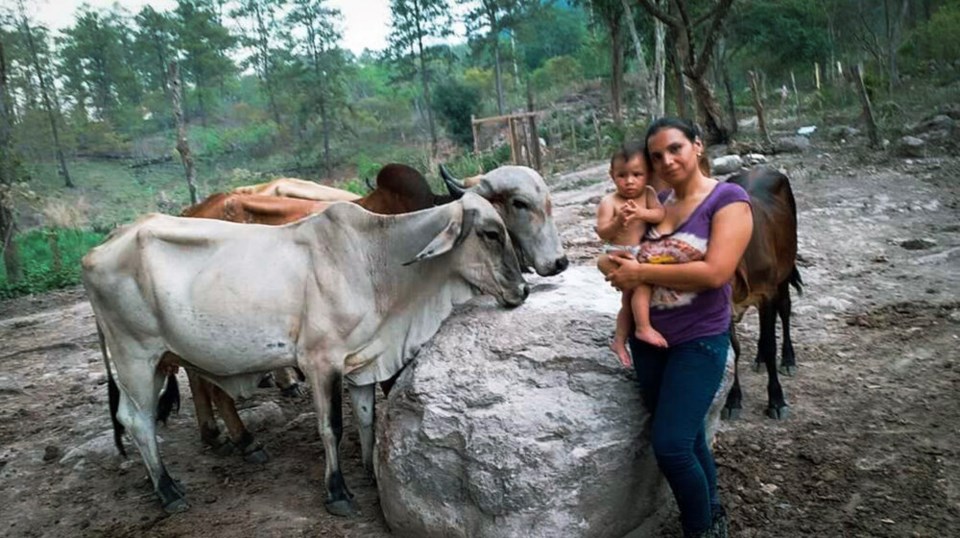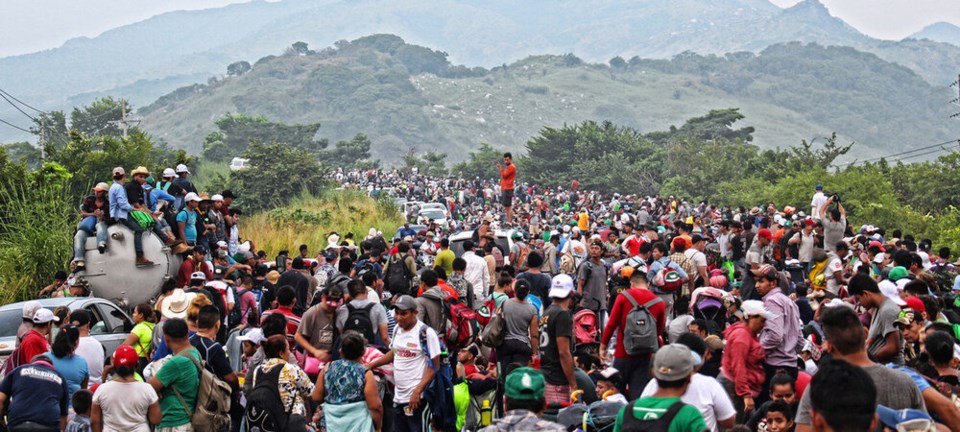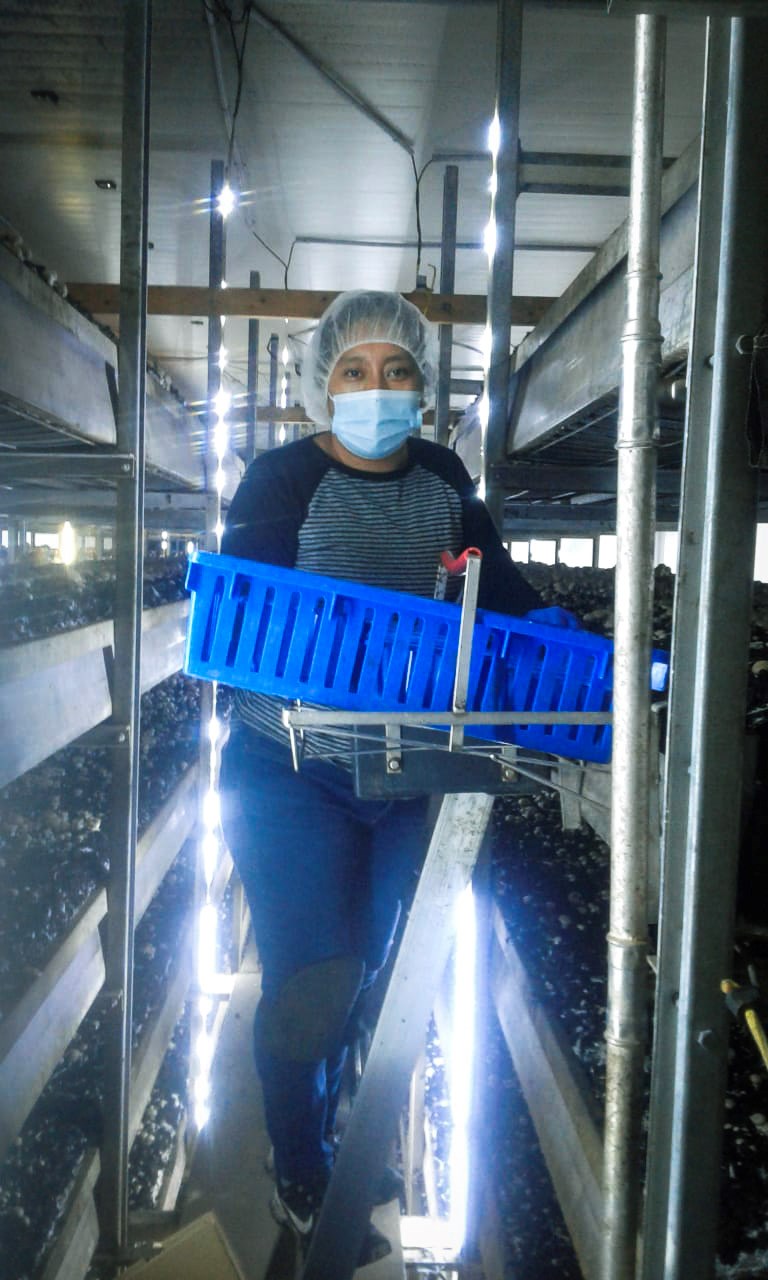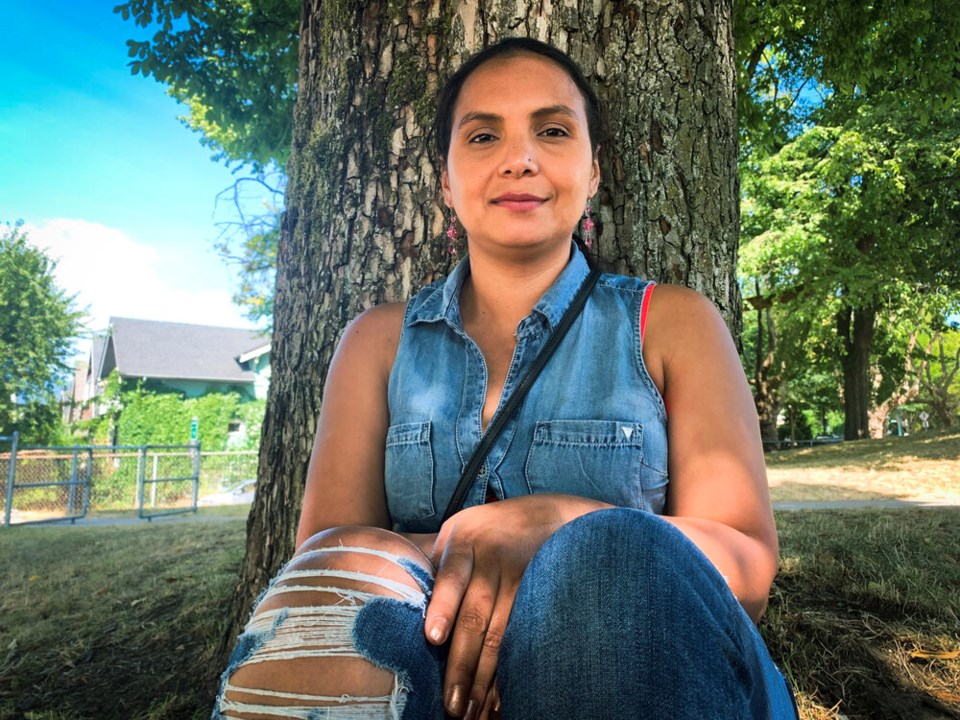In February 2021, Ana Hernandez stood on the south bank of the Rio Grande River cradling her two-year-old son as they waited to climb into a smuggler’s inflatable boat.
North of the border, an unprecedented deep freeze gripped Texas in sub-zero temperatures.
“We'd never felt such cold. Never,” she says.
Together with her husband, Hernandez had spent a treacherous two months fleeing Honduras, where the land and people had turned against her. Five years of drought had forced the young mother’s father to sell half the family’s cattle. In the wet season, flash floods rose the level of the neighbouring El Cajon Reservoir, swallowing huge tracks of farmland where the family grew corn, beans and coffee.
“Imagine a year where everything is dry. Then comes the water. The earth softens and the landslides come,” says Hernandez. “The earth fell with all the coffee plants.”
Under a changing climate, the Hernandez family is one of hundreds of thousands of Central Americans driven from their lands under a confluence of drought, flood, poverty and violence.
Many of those displaced in recent years have migrated to other provinces or neighbouring countries. For others, salvation lies to the north, through Mexico to the United States, and for a growing minority, on to Canada.
By 2050, the World Bank estimates climate change will displace within their own borders as coastal cities and island nations vanish under rising seas and drought grips wide swaths of the African Sahel and Central America.
The number of people forced to move because of climate change could be driven down by up to 80 per cent if the nations cut emissions and plan for migration.

At a global scale, how many seek refuge across international borders will come down to millions of individual decisions. The pressures are enormous.
According to one groundbreaking study in the journal , climate change could lead to one of the largest migrations in the history of humanity.
For thousands of years, humans have concentrated their lives in a small band of livable temperatures. But as global emissions heat the planet, researchers predict the temperature experienced by an average human will change more in the next 50 years than it has over the past 6,000.
Absent migration, one-third of humanity — most in the poorest regions of the world — will live under Sahara-like temperatures found today in less than 1 per cent of the planet’s surface.
Migration, say several experts interviewed for this story, offers a proven safety valve for desperate populations looking to start over.
“When people are allowed to move internationally, that tends to reduce their level of exposure, their level of vulnerability to climate change,” says Hélène Benveniste, a researcher and environmental fellow at the Harvard University Center for the Environment, who has modelled migration flows due to climate change across dozens of countries.

Buffered by a wealthy United States to the south, Canada sits in an outstanding geographic position to pick and choose who crosses its borders. It’s a choice some advocates now say needs to be re-examined as the global climate makes large tracts of land uninhabitable.
In a forthcoming report, a group of Canadian refugee lawyers is calling on the Canadian government to open up new legal pathways for climate migrants to reach Canada.
“We're trying to proactively think of options that don't require radical change, that can be piloted at a time when numbers are quite reasonable,” says Warda Shazadi Meighen, co-author of the upcoming report from the Canadian Association of Refugee Lawyers.
Canada doesn’t recognize climate migrants under current immigration law. But Shazadi Meighen says in past natural disasters — such as the 2010 earthquake in Haiti and the 2004 Boxing Day tsunami — the Minister of Immigration, Refugees and Citizenship Canada offered special directives to prioritize certain nationals to seek refuge in Canada.
“That designates entire classes of people as individuals who can be settled in Canada under permanent residency,” says Shazadi Meighen.
Which countries would qualify for the humanitarian and compassionate pool would be a bureaucratic decision left to the minister, recommends the report.
A second solution, says the group of lawyers, would be to include climate migrants under the country’s private refugee resettlement program. Just like the Canadian government offered a special status to help resettle roughly 60,000 people fleeing war in Syria, it could could create a special category for climate migrants desperate for a way out, the report says.
“The goal is really to explore what can be done,” says the lawyer. “There's also broader debates about changing the definition of who counts as a refugee.”

CLIMATE SETS THE STAGE
Hernandez spent her youth in a rural corner of Comayagua in central Honduras. Some of her strongest memories from that time come in the wake of Hurricane Mitch, when the second-deadliest storm in recorded history devastated her country.
In total, 15,000 people died and a million were left homeless. The resulting poverty has been linked to a rise in crime rates and sprawling migration.
For a week and a half the family was left incommunicado, without food or connections to the outside world after floods wiped out nearby towns and the road to the regional capital.
“At that time, I had two sisters in Canada. Thank God, they helped us a bit,” she remembers. “They helped me with money to keep studying.”
The first sibling to go to university, Hernandez's father wanted her to study medicine. But growing up in a country struggling to rebuild made her choose another path.
One day, she saw a picture of San Francisco’s Golden Gate Bridge and imagined, “I would build things like that.”
But while Hernandez left for the capital, Tegucigalpa, to study, millions of other Hondurans fled the country. Today, the town she grew up in, Las Lajas, has been gutted of young people who migrated to survive.
“Many people ended up without land, sources of work dried up, it was really difficult. That's more than 20 years ago. I still feel like this hurricane is affecting my country,” she says.
For a few years, Hernandez was on the path she dreamed for herself — her civil engineering degree led her to build several structures on a U.S. Air Force base known as Soto Cano, and she was soon running her own company back home building gas stations and houses.
“My father was proud,” she says.
Hernandez says she was never one to collaborate with local politicians; soon, corruption got in the way.
“If you have a good connection in politics, you have work. But if not?”
Work dried up and so too did the fields she was now helping her father tend.
“It was two extremes. Sometimes it was drought and then the next year came and it rained. It rained, it rained a lot,” she says.
Hernandez took a job in a restaurant, met her husband Alex in 2017 and soon fell pregnant with their first child. Together on the land, the family did their best to survive with what they had.

THEY ARRIVED BY FORCE
One day in 2020, an eight-month-pregnant Hernandez and Alex walked down to the banks of the reservoir to check on their cornfields.
Hernandez remembers the drone of a motor, a small boat arriving at the shore. Out of nowhere, six masked men surrounded them, holding pistols to their heads.
“They told us to leave, that if we didn't leave they'd kill us because now they were the landlords,” she says through tears. “It was really hard. Really hard.”
In February 2020, the whole family fled the land they had known as home for 40 years — the father to a neighbouring province, Hernandez to the nearby city with her husband and soon-to-be-born son.
For months, they lived off remittances from Hernandez’s sisters in Langley, 小蓝视频 When they went to the police, the threats got worse. She says she soon learned that the “invaders” who took her family’s land were connected to a senior local politician and the notorious Mara 18, one of the most violent transnational crime groups in the region.
“Imagine them telling you they'll kill your son,” she says.
After multiple death threats, they fled the city of Comayagua on New Year’s Eve. They had a little more than $500 in their pocket, their Honduran passports and diaper bag of clothes and other essentials.
First, the family travelled by bus to Guatemala, to a stretch of border shared with Mexico and the Pacific Ocean. Hernandez recalls the next two months travelling through Mexico as a blur of luck and folly. In some moments, locals would smuggle the family across rivers with contraband bananas; in others, the family raced motorcycles across Mexican beaches under the cover of darkness, desperately trying to reach a town before the federal police went out on patrol.
Early on, the family had their money and cellphone stolen at gunpoint. But Hernandez also says they passed through the mountains and jungles of Mexico on the back of generosity — a free ride in a vegetable transport truck, another passenger stepping up to pay their fare.
When the family reached the border town of Reynosa, the family was hopeful they’d soon cross into Texas; from there, they'd make their way north to the Canadian border where her sisters lived.
But when they arrived in Reynosa, four people were waiting, says Hernandez.
“They took us to a place where a house had burned down. There were a ton of people dressed like police. We saw a group of ‘pollos’ (migrants) some 50 people in line,” recalls Hernandez.
When they learned the Hernandez family was broke and that their toddler had come down with COVID-19 symptoms, they beat Alex, and held guns to their heads. Only an intervention from one of the more sympathetic Gulf Cartel gangsters saved their life, says Hernandez.
The family was left on the side of the highway near a cemetery. Hernandez says they walked until they hit the gates of a ranch, a place where the foreman “treated us like family.”
For two weeks, Alex worked as a ranch hand while his wife nursed their son back to health. When they decided it was time to go, they were only 10 minutes from the river separating them from Texas.

THE FINAL PUSH TO CANADA
The Hernandez family arrived on the banks of the Rio Grande just as Texas was under one of the worst in recent memory.
A coyote, or people smuggler, shuttled them across on an inflatable dingy as snow fell around them. The family took no more than a few steps onto the American side of the river when the U.S. Border Patrol stepped out of the brush.
Hernandez says they were taken by truck to McAllen, Texas, where they were placed in a detention centre with thousands of other undocumented migrants.
After a two-month journey, Hernandez called her sister in San Antonio and the family was released.
Hernandez says they waited little time before jumping on a plane and flying to Bellingham, Washington, where they caught an Uber to Peace Arch Park on the 小蓝视频-Washington border.
“We walked across the park and presented ourselves to the border guards as refugees,” says Hernandez.
That was in January 2021. In the months since, Hernandez has been reunited with her sisters in Langley. Alex is working in construction and Hernandez hopes to one day pick up where she left off as a civil engineer.
When the family had a refugee hearing on Sept. 17, there was no room to speak of drought or flood, no room to make their case that decades of environmental pressures led to wave after wave of violence and corruption — eventually landing one day in their cornfield. Whether the threats to their life will be enough to let them stay in Canada remains an open question.
“They didn’t ask me many questions,” says Hernandez. “They didn’t ask me anything about climate change.”
‘THERE ISN'T A POLICY’
Under the 1951 , a “refugee” is defined as person who has left and can't return to their country “owing to a well-founded fear of being persecuted for reasons of race, religion, nationality, membership of a particular social group or political opinion.” Advocates now question whether the 70-year-old document needs an overhaul to reflect the pressures brought on by a changing planet.
For now, Canada shuts its doors on climate migrants at every turn, says refugee lawyer Shazadi Meighen.
“They are here, but there's no specific avenue to be considered because of climate migration,” she says. “There isn't a policy. There isn't a proactive way we've thought about how to have these people here.”
In an email to Glacier Media, a spokesperson for Immigration, Refugees and Citizenship Canada (IRCC) says addressing climate change and its effects are a priority for the Government of Canada.
“Immigration, Refugees and Citizenship Canada (IRCC) continues to monitor the implications of climate change on migration and displacement patterns and flows,” writes the spokesperson. “In the event of natural disaster, decisions on actions by the Government of Canada are taken on a case-by-case basis.”

CLIMATE MIGRANTS ALREADY HERE
That focus on natural disaster has done little to help people like 55-year-old Valerio Tezen, who escaped poverty in Guatemala after his flower crops collapsed.
He grew up on a farm outside of San Juan Sacatepéquez, a town that in recent years has grown on the doorstep of Guatemala City.
For decades, his family cultivated carnations, chrysanthemums and roses, mostly for export to countries like Canada and the U.S.
First it was the "plague," as Tezen recalls, waves of pests that drove farmers to purchase expensive greenhouses.
In the coming years, rainfall across Central America is expected to decrease by up to 60 per cent in a belt of land known as the “dry corridor,” stretching from the highlands of Guatemala south into El Salvador and eastern Honduras.
Tezen says many in his town have already reached a breaking point.
In one corner of the municipality, a cement factory moved in a few years ago, pitting thousands of locals against an industrial behemoth that requires huge amounts of water.
On the surrounding lands, Tezen says big landholders cut down trees, which used to anchor the region's soil and act as windbreaks for the flowers.
“They are people who have money. They don’t care about the small families supporting themselves with flowers,” he says.
Drought came. Tezen says they were so desperate for water he dug wells with his hands.
Some have tried to grow vegetables like cilantro, radishes, tomatoes and peppers. But many have been pushed out of the countryside and into the city looking for work.
“I can’t grow more flowers, there’s no water,” he says.

For Tezen, that meant borrowing money to buy a pickup truck, used to deliver flowers and furniture to people’s homes. But with nine children, his expenses grew and keeping up with bills was hard.
Three times Tezen looked to Canada as a way out, a way to feed his family.
Four years ago he finally got his break under Canada’s migrant worker program. But that break came after several $800 applications, money he borrowed. Every denial left him in a deeper hole with loan sharks.
“If we were in Guatemala, we wouldn’t be speaking with you. They’d kill us,” he says.
Today, the family is scattered. Tezen is on a two-year contract taking care of 50 calves on a farm outside Drummondville, Quebec; his wife works as a migrant labourer on a mushroom farm in Oshawa, Ont., where she recently caught COVID-19, and their children are with their grandparents back in Guatemala.

Every night, the family has a group video call on WhatsApp.
“They tell me, ‘I want to hug you, papa. I want you here,’ They cry. They’re suffering,” he says. “I feel like I’m alone.”
Still, Tezen says he’s grateful for the chance to come to Canada, grateful he’s found a way to survive after so many hard years.
Like the Hernandez family, Tezen is part of a hidden group of climate migrants who have already arrived in Canada — it’s just that current Canadian immigration law makes them invisible, says Shazadi Meighen.
“I do have people who have said the economic conditions in my country aren't good — there's a famine, there's a shortage, there's a drought. Those kinds of cases have come to me, but they haven't used those terms [when they seek asylum or try to immigrate] because I know there isn't a specific avenue for them,” says Shazadi Meighen.
“There's nothing I could do.”
Stefan Labbé is a solutions journalist. That means he covers how people are responding to problems linked to climate change — from housing to energy and everything in between. Have a story idea? Get in touch. Email [email protected].




